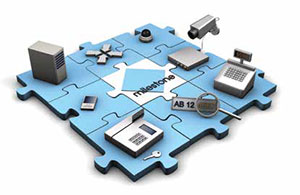
Three Phases of IP Video Evolution
Planning ahead can prevent harm to people and the bottom line
- By Lars Thinggaard
- Apr 01, 2013
 Milestone Systems’ sustained growth during
its first 15 years is attributed to its introduction
of the open-platform approach to the
security industry. By allowing other companies
and developers to add functionality
to the software and supporting the widest choices of servers
and cameras, Milestone’s open platform has radically affected
the industry. This concept has attracted more than 6,500 partners
from around the world, and within just five years, it has
become the foundation for a thriving business ecosystem.
Milestone Systems’ sustained growth during
its first 15 years is attributed to its introduction
of the open-platform approach to the
security industry. By allowing other companies
and developers to add functionality
to the software and supporting the widest choices of servers
and cameras, Milestone’s open platform has radically affected
the industry. This concept has attracted more than 6,500 partners
from around the world, and within just five years, it has
become the foundation for a thriving business ecosystem.
Open platform has created the freedom for both partners
and customers to not only select their own video system components,
but also to create, define and tweak solutions to suit
their security needs. Milestone was aware of the need to shift
analog to digital, and then introduced the open platform as a
new avenue for using surveillance video.
For the surveillance industry, the decision to “go open” was
the motivation for a series of developments that mark three
distinct phases in its growth.
First Phase: IP Video Technology
When Milestone started in 1998, video surveillance was 100
percent analog. CCTV was synonymous with video surveillance,
and even though the concept has changed a lot since
then, most people still think of analog video when they think
of video surveillance. Video surveillance is a tool to view and
record video images, and the public generally considers it used
in security only.
With the advent of the digital revolution and the drop in
price of digital storage, the shift towards digital video surveillance
became certain. Digital images were clearer, storage
media were getting smaller and video compression improved
dramatically. Digital files could be moved more easily, footage
could be found more quickly—no more spooling tapes
back and forth—and long-term storage had no effect on
image quality. It was the way to the future. For many there
were clear advantages in purchasing a digital video solution,
but in practical terms it was not much different
from analog in the way it was used. It was still basically
a security tool.
Second Phase: Video Integration
The Internet brought with it a new electronic infrastructure
that made IP applications like email, instant
messaging, peer-to-peer file sharing and VoIP widely
available. Digital video was soon added to this list, and
saw application in video conferencing and, of course,
video surveillance.
The main advantage of networked applications was
that they were programmable, and this opened up a
range of other benefits. These typically included better
user experiences, network visibility and control, better access
to data and development advantages, notably in the form
of tailor-made video integrations.
One can program a simple IP network to give a building
administrator an overview of controllable doors or gates in a
building, so they can be locked and unlocked remotely. However,
by integrating surveillance video with this existing network,
access control can be given a higher level of sophistication
and efficiency by combining it with possible security-related
evidence or by ultimately automating the access procedure
through the use of video content analysis—face recognition,
in this case.
With Milestone’s introduction of the open platform standard,
it was soon apparent that innovations in this area were
going to be driven by the Milestone partner alliances. Its innovative
partner ecosystem was the driver in identifying customer
requirements and creating distinctive and revolutionary
video integrations.
Third Phase: Video Enabling
It was clear that video integration with other IP-based systems
was going to change the face of video surveillance. While new
video integrations were a natural result of a growing and diversifying
partner ecosystem, Milestone recognized the new
definitions that networked video was beginning to offer to the
world of video surveillance. Companies were starting to adapt
their existing video solutions for other uses, for purposes that
optimized and improved their business processes.
Video enabling is to video surveillance what the smartphone
is to the telephone: it is an added set of functionalities that
surpasses the original concept. We no longer use phones only
to make calls. We use them to take photos, record video and
audio, surf the Internet and play games. Third parties are constantly
adding new applications to make the user’s smartphone
experience more rewarding.
Video enabling simply means that video surveillance has
shifted into a new paradigm of usability and application. This
is because of the unique combination of network programmability and the extensive partner ecosystem
made possible by the open platform
standard.
For Milestone, the recognition of
these new possibilities is not passive;
it is a motivation to mobilize a greater
awareness of video integration’s scope.
It is a call to action to partners and
customers alike that video enabling—
the optimization of business processes
through video—is the way forward. It
is not a move away from security, but
rather an addition of function to that
of traditional asset protection and loss
prevention. The amount of revenue generating
potential inherent in video
enabling is a “win-win-win” for vendors,
partners and the customers.
There are a number of possible ways
in which companies can video enable
their businesses. Here are just a few:
- Workers can be monitored to enforce
compliance with protective
clothing and safety equipment or
procedures, preventing loss due to
fire, chemicals, accidents and injury.
- Prevent queuing at point-of-sale locations
by notifying when extra staff
is needed.
- Alert maintenance crews to impending
structural failures in buildings
and vehicles.
- Retailers can use video to track traffic
patterns, measure the effectiveness
of displays and other merchandising
strategies, and devise ways to
increase sales or visits.
One retail chain in Ireland initially
installed a video solution to keep an
eye on its parking lot. They realized by
adapting it with video content analysis,
they could be alerted when someone
parked in the disabled person’s bay. A
mobility chair could then be dispatched
immediately, providing improved customer
service.
In the same vein, a vegetable farm in
the United States used its video installation
for more than security by integrating
an access control system to optimize
the timing of harvesting trucks,
decreasing queuing time, ensuring the
shortest amount of time between picking
and delivery, and thereby delivering
a better quality product.
According to the Loss Prevention
Research Council’s (LPRC) “CCTV in Retail 2012” report, in the category of
Video for Sales, Marketing and Operational
Efficiency, “of the retailers who
use IP-based video systems for cross functional
benefits outside of security
and loss prevention, 93 percent have
seen a positive impact on operations,
while 40 percent have seen a positive
impact on merchandising,” and “nearly
one quarter named ‘integration with
business intelligent video, such as analytics
and POS integration’ as a main
driver for adopting a network/IP system.”
These are significant numbers,
and an indication that the retail sector,
for one, is making giant strides in
adopting video-enabling solutions.
Milestone’s vision is to drive the
convergence of video surveillance and
IP-based systems. This is not only an
open acknowledgement of the new direction
that video surveillance is taking;
it is an assumption of initiative
and a rallying call to lead the security
industry toward video enabling and
optimized business processes.
This article originally appeared in the April 2013 issue of Security Today.